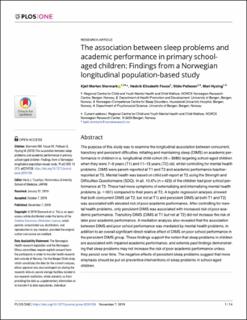| dc.contributor.author | Stormark, Kjell Morten | |
| dc.contributor.author | Fosse, Hedvik Elisabeth | |
| dc.contributor.author | Pallesen, Ståle | |
| dc.contributor.author | Hysing, Mari | |
| dc.date.accessioned | 2020-03-30T13:45:48Z | |
| dc.date.available | 2020-03-30T13:45:48Z | |
| dc.date.created | 2019-12-10T10:05:36Z | |
| dc.date.issued | 2019 | |
| dc.identifier.citation | PLOS ONE. 2019, 14:e0224139 (11), 1-14. | |
| dc.identifier.issn | 1932-6203 | |
| dc.identifier.uri | https://hdl.handle.net/11250/2649449 | |
| dc.description.abstract | The purpose of this study was to examine the longitudinal association between concurrent, transitory and persistent difficulties initiating and maintaining sleep (DIMS) on academic performance in children in a. longitudinal child-cohort (N = 3986) targeting school-aged children when they were 7–9 years (T1) and 11–13 years (T2) old, whilst controlling for mental health problems. DIMS were parent-reported at T1 and T2 and academic performance teacher-reported at T2. Mental health was based on child self-report at T2 using the Strength and Difficulties Questionnaire (SDQ). In all, 10.6% (n = 423) of the children had poor school performance at T2. These had more symptoms of externalizing and internalizing mental health problems (p. < 001) compared to their peers at T2. A logistic regression analysis showed that both concurrent DIMS (at T2, but not at T1) and persistent DIMS (at both T1 and T2) was associated with elevated risk of poor academic performance. After controlling for mental health problems, only persistent DIMS was associated with increased risk of poor academic performance. Transitory DIMS (DIMS at T1 but not at T2) did not increase the risk of later poor academic performance. A mediation analysis also revealed that the association between DIMS and poor school performance was mediated by mental health problems, in addition to an overall significant direct relative effect of DIMS on poor school performance in the persistent DIMS group. These findings support the notion that sleep problems in children are associated with impaired academic performance, and extends past findings demonstrating that sleep problems may not increase the risk of poor academic performance unless they persist over time. The negative effects of persistent sleep problems suggest that more emphasis should be put on preventive interventions of sleep problems in school-aged children. | |
| dc.language.iso | eng | |
| dc.rights | CC BY 4.0 | |
| dc.rights.uri | https://creativecommons.org/licenses/by/4.0/ | |
| dc.title | The association between sleep problems and academic performance in primary school-aged children: Findings from a Norwegian longitudinal population-based study | |
| dc.type | Peer reviewed | |
| dc.type | Journal article | |
| cristin.ispublished | true | |
| cristin.qualitycode | 1 | |
| dc.identifier.doi | 10.1371/journal.pone.0224139 | |
| dc.identifier.cristin | 1758646 | |
| dc.source.journal | PLOS ONE | |
| dc.source.volume | 14:e0224139 | |
| dc.source.issue | 11 | |
| dc.source.pagenumber | 1-14 | |

